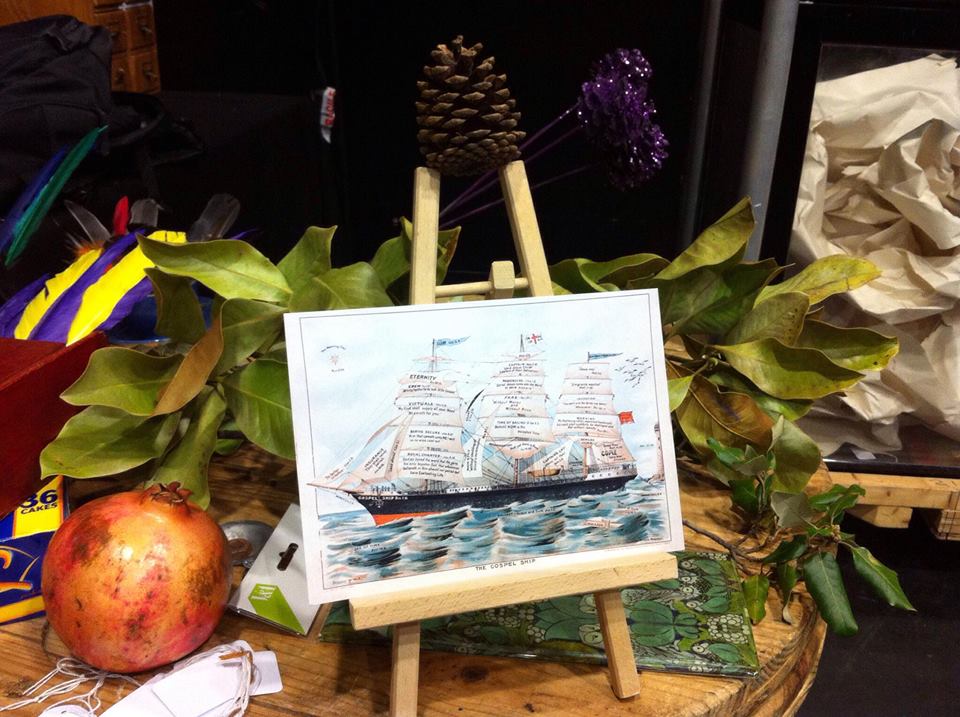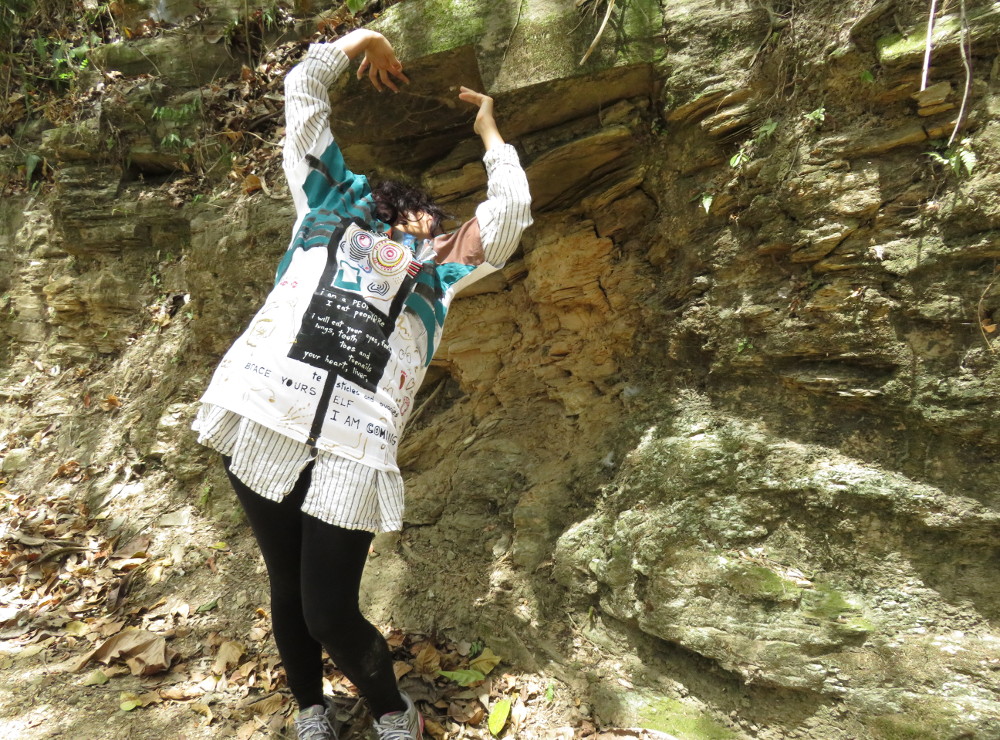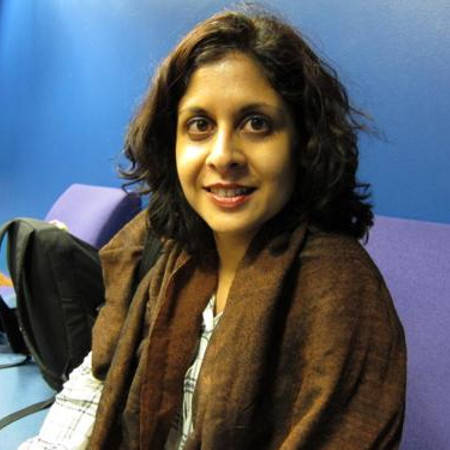In a series of experiments with breaking away from poems on the page to create immersive installations, I have been seeking to re-create what the process of enjoying reading or writing poetry feels like. A habit of concentration was given to me in childhood by poetry-loving folk; so I was always privileged to fall through a portal-like page, into worlds whose colour, sound and movement momentarily displaced everything. However, reading is not like this for everyone. It is easy to blank at the sight of a poem, reject it as ‘too personal’, or agonize over its ‘meaning’. Its words may not whisper or sing; the mistrustful imagination voices them like a tired performer mumbling in a marquee, or a strident teacher. So I desired to create active silence in a room filled with happy concentration. The intention was not to abandon the poem, nor to illustrate it, but to offer a magic gift: a relaxed, humming brain-cave you can step into. Who can explain this feeling intellectually? What it feels like, after learning by heart, reading aloud, copying by hand, analyzing at length, even or especially writing that you don’t ‘like’ or ‘get’ – to acquire the technical ease of slipping fearlessly into the deeps of a poem?
‘Azure Noise’, playing both on ‘white noise’ and Mallarmé’s poetry-ships sailing into the symbolic azur, was the title of one instantiation, co-created with Jeremy Hardingham, the genius manager of the Judith E. Wilson Drama Studio. Our soundscape’s word-shimmer would invite the audience to unplug and re-tune, unravelling the worried, mediatized buzz of everyday modernity. We selected texts with round vowels and liquids, or mentions of blue-green colours, mirrors, ice, and water. These included contemporary Latin American and Caribbean poetry, medieval Welsh, Ursula Le Guin, Angela Carter, and my Undraining Sea. We layered recordings featuring diverse volunteer readers, and placed four devices playing different soundtracks at different points in the studio. Because only occasional words rose to the surface, listeners were encouraged to enter a dreamlike state, open to wandering with and into poetic meaning rather than wrestling with ‘correct’ responses. The shifting interzones of murmurs, just under hearing level, positively countered the noise that public spaces enforce.
 After sound, the second key element was movement. We developed a ‘kinetic syntax’ approach, also intended to unlock the living feel of poems, rather than what they seem to talk about. In this approach, interpretative gestures, such as river = wavy arms, were banned. Instead, Jeremy’s core response would make visible shapes that could convey the feeling of the small movements that add up to the sense of how a text is creatively formed. We analyzed our texts down to their linguistic skeletons. Phrases or fragments? Lines – run-on or end-stopped? Verb tenses – changing, past, present, infinitive? Grammatical structures, repetitions? What was ‘dancing’ in the language, through the if, or, when, then, and, but, O! – not the who and what? This liberated his viewers to ‘dance with’ the poetry, becoming empathetic rather than being trapped in literalism.
After sound, the second key element was movement. We developed a ‘kinetic syntax’ approach, also intended to unlock the living feel of poems, rather than what they seem to talk about. In this approach, interpretative gestures, such as river = wavy arms, were banned. Instead, Jeremy’s core response would make visible shapes that could convey the feeling of the small movements that add up to the sense of how a text is creatively formed. We analyzed our texts down to their linguistic skeletons. Phrases or fragments? Lines – run-on or end-stopped? Verb tenses – changing, past, present, infinitive? Grammatical structures, repetitions? What was ‘dancing’ in the language, through the if, or, when, then, and, but, O! – not the who and what? This liberated his viewers to ‘dance with’ the poetry, becoming empathetic rather than being trapped in literalism.
Time and space remained to arrange. Not everyone pays poetic attention when they have to listen ‘properly’. Some people need to move about or to make or even destroy something, to access that zone of feeling and/both, switched on/switched off. To break the association between poetry and school discipline, we decided the audience could drop in and out any time during a four-hour continuous performance. They were not required to be well-behaved spectators. So we placed mattresses and sheeting on the floor, to encourage lounging; chairs facing various directions; and objects to play or make art with.
Swathes of fabric: velvety, translucent, netted, slippery, blue, silvery, green: hammocked and hummocked the ‘black box’. Paige Smeaton, with expertise carried over from Ceredigion Museum, provided the focal point in the entrance sightline, slowly metamorphosing into a Mabinogion bird. Along the studio’s left wall was a corridor of mesmeric motion. Olivia Scott-Berry, hooded and facing away, repurposed bills and receipts, painting them with shapes like drowsy waterfowl. Hope Doherty, like the sellers of holy items on the causeway to a Sufi shrine, had a stall of simple, lustrous things: beads, marbles in water-filled Ziploc bags. She made non-stop, gentle offerings, like a happy Ophelia drowning among her wares. Along the right wall Jeremy Hardingham evolved a barefoot fire and water ritual. Meantime, hidden on a platform, I read water poems clearly, but softly, so the audience could choose their level of engagement. This was the creation of active silence. Few would go away with ‘a meaning’, but with the memory of an enriching atmosphere, and perhaps, imperceptibly, a little changed in their access and approach to poetry.
© Vahni Capildeo
Images Top: Kavir Mootoo; above: Paige Smeaton
Vahni Capildeo
Solitary gregarious impossible animal sleeps furiously, writes devouringly, bakes cakes
SEE PROFILE






 After sound, the second key element was movement. We developed a ‘kinetic syntax’ approach, also intended to unlock the living feel of poems, rather than what they seem to talk about. In this approach, interpretative gestures, such as river = wavy arms, were banned. Instead, Jeremy’s core response would make visible shapes that could convey the feeling of the small movements that add up to the sense of how a text is creatively formed. We analyzed our texts down to their linguistic skeletons. Phrases or fragments? Lines – run-on or end-stopped? Verb tenses – changing, past, present, infinitive? Grammatical structures, repetitions? What was ‘dancing’ in the language, through the if, or, when, then, and, but, O! – not the who and what? This liberated his viewers to ‘dance with’ the poetry, becoming empathetic rather than being trapped in literalism.
After sound, the second key element was movement. We developed a ‘kinetic syntax’ approach, also intended to unlock the living feel of poems, rather than what they seem to talk about. In this approach, interpretative gestures, such as river = wavy arms, were banned. Instead, Jeremy’s core response would make visible shapes that could convey the feeling of the small movements that add up to the sense of how a text is creatively formed. We analyzed our texts down to their linguistic skeletons. Phrases or fragments? Lines – run-on or end-stopped? Verb tenses – changing, past, present, infinitive? Grammatical structures, repetitions? What was ‘dancing’ in the language, through the if, or, when, then, and, but, O! – not the who and what? This liberated his viewers to ‘dance with’ the poetry, becoming empathetic rather than being trapped in literalism.